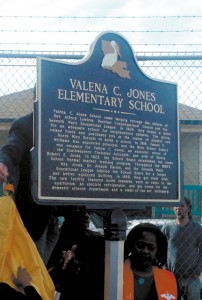School site honored as historic landmark
23rd November 2015 · 0 Comments
By Ashlee Hill
Contributing Writer
It was a Saturday on the grounds of Valena C. Jones Elementary School at 1901 North Galvez St. and a group of its alumni were singing the school’s alma mater while awaiting the unveiling of a historic plaque.
The Plessy and Ferguson Foundation, named after the Supreme Court case that led to the doctrine of “separate but equal,” helped raise about $3,000 in donations from Jones Elementary alumni and its supporters across the city to erect the plaque on November 14 which points out that the Seventh Ward school first opened its doors to African American students in 1905.
Shuttered since Hurricane Katrina, Valena C. Jones Elementary School the auction block this summer. The Orleans Parish School Board had set August 20, 2015 as the auction date to sell off the property to anyone interested in renovating the structure.
That did not sit well within the community.
Spearheaded by Phoebe Ferguson and Pastor Brenda Square, co-founders of Plessy and Ferguson Foundation; Keith Plessy, the president of the Plessy and Ferguson Foundation’s board, Dr. Mona Lisa Saloy, president of the Seventh Ward Neighborhood Association; activists lobbied the school board prior to the auction date to not sell off the “historic landmark.”
Their efforts proved successful.
Henderson Lewis, the superintendent of Orleans Parish schools decided not to auction off Valena C. Jones after Square and others protested.
At the ceremony, Lewis spoke to those gathered about why he changed his mind. “I was impressed by all the facts Square presented when she talked about the school,” Lewis said. “I then decided against auctioning off the school.”
The education that the school gave students helped them as well as the community. The Seventh Ward transformed from being known as the “Bucket of Blood,” to having the highest school population in the area during the early 1900s.
“The area was worn out and dangerous. The school was in a very bad part of the neighborhood,” Square said.
The school created an environment where children were eager to learn in tough conditions.
In 1957, when Hurricane Audrey hit the elementary school, the damages did not stop the children from learning., according to Lolita Cherie, founder of the Creole Genealogical and Historical Association, Inc.
She told the audience that after Hurricane Audrey, the community came together and taught children in corner stores, churches and in houses surrounding the school. The school’s influence made education in the community a priority.
Cherie told the crowd that the school’s highest population was about 2,800 students in the 1930s.
The community, she said, was fully immersed in the school. There was an active parent-teacher association that helped with school events such as the Annual May Pageant and the Annual White Christmas. Cherie recalled that prominent national figures like First Lady Eleanor Roosevelt, civil rights activist Mary McLeod Bethune and professional boxer Joe Louis visited the elementary school to support Black students learning at a time when it was rare for Black students to receive a formal, quality education.
Cherie singled out former principal of the school, Fannie C. Williams for having a life long influence on the school. Williams led the school from 1921-1954 during a time when the Jim Crow era disadvantaged the Black community.
Williams’ 33 years of stewardship impacted the students and the community by, among other things, placing free healthcare resources in the school and guiding students into new ways of learning, Cherie said.
Williams’ holistic approach to teaching created a legacy,” said alumna Beryl F. Hunter. “Attending Valena C. Jones was a wonderful experience,” Hunter said.
The two-sided plaque recognizes Williams and her dedication to the elementary school and on the other side gives a brief history of Valena C. Jones. The community activists at the event hope that the landmark would be the beginning of a citywide effort to identify places of significance to Black history.
The community leaders at the event said they hope such historic markers would continue to remind residents of how far inequalities have come in the city and how much further the city must go in addressing disparities, particularly those in education. Leon A. Waters, the founder of the Louisiana Museum of African American History, told the audience the plaque symbolizes Black empowerment in New Orleans.
“This (plaque) is a marker that symbolizes equality, freedom, more preservation of buildings and markers of our people,” Waters said.
The Plessy and Ferguson Foundation advocates for the preservation of places of historic significance through bringing public awareness to these spaces.
This article originally published in the November 23, 2015 print edition of The Louisiana Weekly newspaper.



